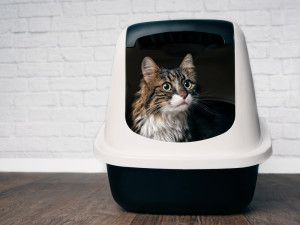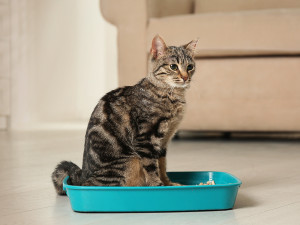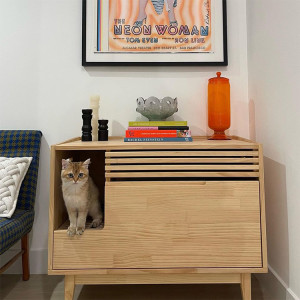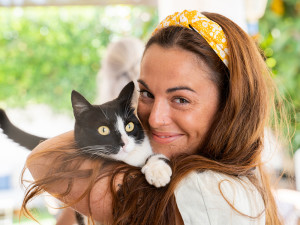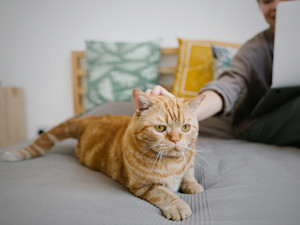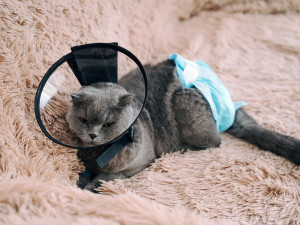What to Do When Your Cat Refuses to Be (Litter) Boxed In
A cat behaviorist explains why they are so particular about where they pop a squat.

share article
Generally, cats can teach dogs a thing or two about doing their business. If you let them, a dog will walk right past a tree to lift their leg on your neighbor’s car rims, then strategically poop at the bottom of another one’s stoop. Besides the fact that cats can be trained to use a human toilet (haven’t you seen Meet the Parents?), these diminutive geniuses will politely regulate their BMs to a litter box — that is, until they won’t.
It turns out there’s a lot more going on in a litter box than numbers one and two. Come on, think of your own five-step nightly skincare routine — cats have their particular habits, too. While they’re not exactly trying the latest pore serum in there, cats do get up to other activities in their litter boxes, including guarding and playing in it. But avoiding the litter box altogether? Not cool, kitty. We caught up with Dr. Niwako Ogata, director of the Purdue Animal Behavior Clinic at Purdue University, to get the scoop (pun intended) on why this happens and what you can do about it.
Change is bad
OK, change is good, but don’t expect your cat to be down with it. Many pet parents believe their animals spite-pee and revenge-poop to show their disapproval for something, like losing sleeping-in-bed privilegesopens in a new tab thanks to a new partner. The argument can be very convincing, especially when they seek out your pillow when there are umpteen less gross, but equally rude, locations to stage a protest. But Dr. Ogata says anxiety is more likely to blame when a cat won’t use the litter box and adds that cats are notoriously fussy creatures who may react to the slightest change in their environment — even just a new type of litter.
Location, location, location
The grass is always greener…or the rug softer. Maybe it’s the downy material or the absorbency or how it’s just so nice to kneadopens in a new tab. The jury’s out as to why many cats prefer rugs to litter boxes, but if yours is guilty, either limit their access to the room with the rug in question or spray it with a sour-smelling deterrent. Another favorite place to ‘go’ — which admittedly makes more sense — is in a potted plant, where they can bury their business. If your cat has abandoned the litter box (or never attempted to use it in the first place) consider where it is located. Dr. Ogata recommends a quiet, private area that’s easily accessible and far from their food and water bowls — but not so far that it shares the basement with a scalding furnace or the laundry room with loud, clanking machines.
Size matters
Most cats prefer larger litter boxes and litter made from small, clay granules (as opposed to silica or wood pellets). Some may care not for privacy and avoid litter boxes with lids. Dr. Ogata also says that you should pass on litter boxes disguised as household objects like side tables and ceramic pots. They are purely aesthetic — something your cat will not appreciate (and then will proceed to poop under the bed). She adds that “an open shape is better.”
Comfort zone
“If there is a sudden change in litter box habits, make an appointment with the vet to rule out medical causes,” Dr. Ogata says. Cats can get UTIs, too, which causes pain when they pee. They could assume that the litter box has something to do with it and associate pain with it. Climbing into and out of a litter box could also present a challenge to an aging, arthritic cat.
Private and guest baths
If you have multiple cats, it follows that you have multiple litter boxes — you should, anyway. Dr. Ogata suggests one litter box per cat, plus one extra. So, two cats equal three litter boxes? That’s right. It’s not that your cats are divas; it’s just in their nature to be territorial. “In multi-cat households, cats can be bullies and the aggressor can block access to the litter box,” she explains. Observe your kitties and place litter boxes where each one likes to spend time — the farther apart, the better.
Clean up your act
Your cat feels about a dirty litter box the way you do about a dive bar’s restroom. The sight or scent of poop will send them running in the opposite direction. “The most important thing to a cat is the cleanliness and smell of a litter box,” Dr. Ogata says. “A spot that is wet, dirty, or smelly will deter them from going back.” And if they are well trained, they will hold it, which can cause bladder and kidney issues. If you’ve been eyeing automatic litter boxes, you may need to think twice. The unexpected motor noise or motion can startle sensitive cats. Get into the habit of scooping out the litter box at least once a day — set an alarm on your phone as a reminder. Your cat will thank you by pooping where they are supposed to.

Jodi Helmer
Jodi Helmer is a North Carolina-based freelance writer who shares her home with an embarrassing number of rescue dogs and relies on four feral cats to patrol the barn. When she isn’t refilling food and water dishes, Jodi writes about animals for Scientific American, Sierra, WebMD, AKC Family Dog, Living the Country Life, and Out Here.
Related articles
![Small orange cat in wooden litter box.]() opens in a new tab
opens in a new tab9 Litter Box Enclosures That Aren’t Total Eyesores
Keep your cat’s litter box out of sight — but easy to scoop.
![Woman holding her black and white cat.]() opens in a new tab
opens in a new tabThe Ultimate Shopping List for Your New Cat
It’s National Kitten Day! Here are all the new cat essentials you need, recommended by real pet parents.
![Cat laying inside a cat tree]() opens in a new tab
opens in a new tabCat Trees That Won’t Clash With Your Aesthetic
Stylized cat trees for every personality, from cartoon flowers to modernist towers. We hope money grows on a few of them.
![Owner pets senior ginger cat.]() opens in a new tab
opens in a new tab6 Common Health Concerns in Senior Cats
How to spot and how to treat them.
![Gray cat laying on a fuzzy pink blanket with a protective cone around its head and a blue diaper on]() opens in a new tab
opens in a new tab5 Best Cat Diapers of 2023
The top cat diapers to combat excitable urinators and leaking caused by incontinence, and help those recovering from surgery.
![cat in a follow tv]() opens in a new tab
opens in a new tab16 Pieces of Furniture So Stylish You Would Never Know They’re for Cats
Mid-century modern coffee table or litter box? Industrial bookcase or cat tower? If you can’t tell, that’s kind of the point.
